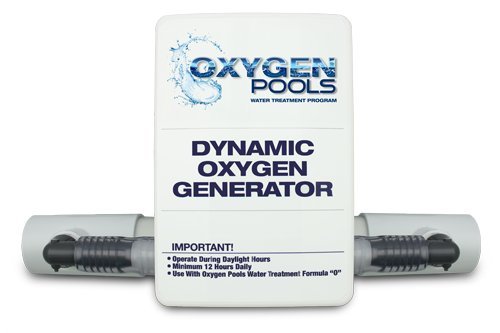
Salt water pools are almost universally considered to be nonchlorine pools. In fact, these pools contain extremely high chlorine levels. Users of these salt systems seem to think that somehow common salt is a disinfectant that does not use chlorine.
The actual technology of a salt system involves breaking salt (NaCl) into its core components, one of which is the active form of chlorine (hypochlorous acid). This chlorine is no different than the various forms of chlorine purchased in liquid, powdered or tableted forms and added manually to the pool.
Copious amounts of stabilizer are required in salt pools to prevent chlorine from being dissipated by UV rays from the sun. This stabilizer (cyanuric acid) brings it’s own set of health concerns and is not required in the Oxygen Pools program.
Salt pools usually require higher chlorine levels than most pools because salt in the water creates a high pH environment and chlorine is much less effective at pH levels of 7.6 or highr. Most salt pools tend to run a pH of 7.6-8.1 and, in these alkaline conditions, chlorine is ineffective at normal levels of 1-3 ppm.

HOW EFFECTIVE IS AN OXYGEN BASED TREATMENT PROGRAM?
The actual sanitation demands of a residential pool are quite manageable considering the level of use they usually receive. In the case of oxygen-based treatment, a mechanically produced oxidizer (ozone) is automatically injected into the pool which removes organics from the water quickly and efficiently. Whatever ozone is not used for direct oxidation contributes to dissolved ozone in the water which breaks down to a safe residual level of hydrogen peroxide.
In addition to the peroxide residual, a weekly shock treatment, such as Formula “O”(which includes non chlorine shock, algaecide, clarifier and metal sequestrant) will provide safe, crystal clean water in the vast majority of residential pools.
If a particular pool has unusually high usage or unexpected problems, the regular oxygen based program can be supplemented with a dose of 27% pool grade hydrogen peroxide for a straightforward and inexpensive solution for high demand pools. Pool peroxide is available on the company website and most pool retailers.

STABILIZED CHLORINE AND OXYGEN LONGEVITY IN WATER
The drawback of both chlorine and oxygen (ozone) treatment systems has been the lack of a residual oxidizer in the water. Chlorine requires a stabilizer in the form of cyanuric acid (CYA) to remain stable in water.
There are concerns about the health effects of CYA as well as concerns about the effect of chlorine on humans by absorption into the lungs and it’s irritation of skin and eyes. The issue for many poolowners is that the side effects of chlorine use far outweigh its benefits.
Since are no stabilizers used in an Oxygen Pool, it is a much more effective oxidizer than chlorine, simply lengthening the injection time into the pool will maintain satisfactory levels of residual oxidizer (peroxide) in the water. By continuing to add fresh oxidizers into the water, the oxidation reduction potential (ORP) in water is maintained at levels easily sufficient to maintain safe water.
SHOCKING OF THE POOL
Both chlorine and oxygen treated pools should be shocked regularly. Shocking provides a safety margin against times when the pump is not running or when demand levels spike after heavy rains, winds or high bather loads.
In chlorine pools, shocking is accomplished with extremely high chlorine levels. Conversely, in an oxygen based pool, water is shocked with a particular blend of a nonchlorine activated oxygen additive along with clarifiers, stain protection and algaecide. By shocking the water, a secondary oxidative effect is added to assure safe water in residential pools.

OXYGEN BASED WATER TREATMENT IS NOT NEW
All of the components used in oxygen based water treatment are well known within the swimming pool industry. It is the combination of these technologies (high velocity, mechanical ozone injection combined with activated oxygen additives) that is new to the water treatment field.
What is new in the Oxygen Pools model is the use of high velocity injection of ozone which drives ozone deep into the water where several reactions occur. These include, first, the immediate direct oxidation of contaminants in the water followed by the creation of a peroxide residual which remains in the water.
For most residential pools, which are not occupied by 90-95% of the time, the oxidation demand is quite manageable without traditionally recommended levels of chlorine. These levels were adapted from commercial/public pools which typically experience significantly higher spikes in bather loads and would naturally require much greater levels of residual oxidizer. The use of an oxygen-based system on thousands of residential pools has proven to be viable in keeping residential pool water safe, clean and amazingly clear.


